About the Videographer - Naturalist
Kristen Jabanoski

Kristen is an avid outdoors explorer. She paddles, sails, hikes, snorkels, gardens, just to name a few of her pursuits. Kristen works at the NOAA Lab in Milford.
Some Bryozoan Links
Bryozoan Video #1
September 13, 2021
Magnificent Bryozoans in Lake Quassy
Lake Quassapaug is home to colonies of freshwater bryozoans, a type of invertebrate commonly known as the "moss animals". The scientific name for the species found in the lake is Pectinatella magnifica, or the magnificent bryozoan. Bryozoans are true survivors - they've been on earth since before the dinosaurs, the first fossils appearing nearly 500 million years ago. Like corals on a reef, the colonies are made up of thousands of single animals called zooids. Bryozoans are filter feeders, and individual zooids use their tentacles and cilia to feed on particles in the water column. You can think of them as part of the lake's natural cleaning crew, making the lake cleaner and clearer as they eat. The colonies are gelatinous and roughly baseball to basketball sized. They are pretty rare in Connecticut and have only been documented a handful of times.
The colonies die off in the winter, but not before leaving behind bud-like statoblasts, which fall to the bottom of the lake and survive the winter. These statoblasts will form a new colony in the spring when the lake warms up again. The colonies are mostly found attached to moorings, and they look like an egg mass or a disembodied brain from a scifi movie (but are completely harmless). If you put on a mask and snorkel and look at them closely, you can see the individual animals pulsating. These 'magnificent bryozoans' may also be an indicator of good water quality.